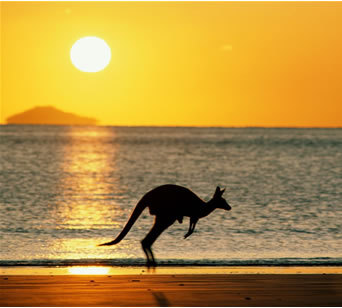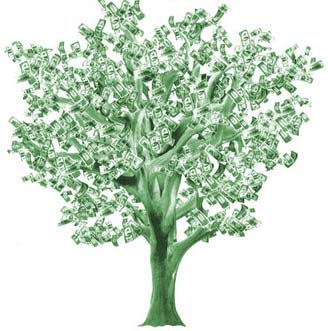How much is nature worth? We can put a price tag on a fish (say, $350,000 for a prime condition bluefin tuna in Tokyo), or even on a salt marsh if it provides a breakwater out front of the house that reduces one’s flood insurance premium. But what about the value of Nature per se–the psychological or spiritual benefit one gets just from knowing it’s out there?
A new study from NOAA concludes that the answer for Hawaiian coral reefs is $33.57 billion.
That sounds like a lot of money to me. But once you get beyond millions my understanding starts to get hazy. So to put this in perspective, $30 billion was the entire annual income of all 125 million people living in Bangladesh in 2008. It was the total Libyan government assets in US banks that was frozen by President Obama last February. $30 billion is the amount that FAO Director-General Jacques Diouf suggested in 2008 would be sufficient to “re-launch agriculture and avert future threats of conflicts over food“. And $30 billion is three quarters of the largest personal fortune in the history of the world ($40 billion), which was reportedly squandered by Sultan and Prime Minister Hassanal Bolkiah Muizzaddin Waddaulah of Brunei after he inherited it from his father.
Most Americans have never seen a coral reef, except maybe on TV. Do they still care? Evidently, the answer is yes. How do we know this? How would one even come up with such a number for the value of some natural ecosystem? A good question — I’m glad you asked. The most straightforward way in principle (though quite tricky in practice) is simply to ask people what they would be willing to pay for it. This is the time-honored approach of economists to many such problems of “valuation”. The NOAA study used a scientifically developed internet survey of more than 3,200 American households – a representative sample of all U.S. residents from throughout the country, not just not Hawaii. Here’s what they did:
“The survey allowed the public to express its preferences and values for protection and restoration of the coral reef ecosystems around the main Hawaiian Islands. In this study, total economic value includes so-called passive use values, such as the willingness to pay to protect the coral reef ecosystem for future generations, as well as direct use values, such as snorkeling over a coral reef or consuming fish supported by coral reef ecosystems . . . To estimate underlying values the public places on coral reef ecosystems, the study team presented survey participants with two specific measures to protect and restore coral reef ecosystems. One measure aimed at reducing effects to coral ecosystems from fishing, and another to repair reefs damaged by ships.”
 A few weeks ago we featured a report estimating the value of Australia’s marine environment at$25 billion. Which raises several questions: Could one habitat–coral reefs–on one oceanic island–Hawaii–really be worth 50% more than the entire ocean in the jurisdiction of the continent of Australia? And, apropos of trying to answer that one, is it really legitimate to assign Hawaii’s reefs a monetary value to two decimal places? That is, what is the basis for concluding that the reefs are worth $33.57 billion rather than, say $33.53 billion — do we truly have that precise a handle on people’s willingness to pay to protect the coral reef ecosystem for future generations?
A few weeks ago we featured a report estimating the value of Australia’s marine environment at$25 billion. Which raises several questions: Could one habitat–coral reefs–on one oceanic island–Hawaii–really be worth 50% more than the entire ocean in the jurisdiction of the continent of Australia? And, apropos of trying to answer that one, is it really legitimate to assign Hawaii’s reefs a monetary value to two decimal places? That is, what is the basis for concluding that the reefs are worth $33.57 billion rather than, say $33.53 billion — do we truly have that precise a handle on people’s willingness to pay to protect the coral reef ecosystem for future generations?
Don’t get me wrong. I’m generally in favor of such economic valuations, mainly because there is an alarmingly large number of people in highly influential positions who will not even put an issue on the table for discussion unless it has a dollar sign attached to it. So if you want conservation to be taken seriously, economic valuation is one of several issues that ought to be considered.
 This practice of economic valuation of ecosystems has been gaining momentum at least since the famous (or notorious) paper by Costanza and colleagues in 1997 that took aim at the entire earth and purported to value its natural systems at $33 trillion (with a t).
This practice of economic valuation of ecosystems has been gaining momentum at least since the famous (or notorious) paper by Costanza and colleagues in 1997 that took aim at the entire earth and purported to value its natural systems at $33 trillion (with a t).
But we also have to approach such valuations cautiously because, in my view, they are inherently dangerous. I’ve come to this conclusion from several years of working with various groups to think about how changing biodiversity might influence the value of “ecosystem services”– jobs that Nature does for us free of charge like providing fresh fish, the natural breakwaters mentioned above, clean air, and so forth.
The main concern I have is this: What if, after all this clever work, we find out that biodiversity actually isn’t very valuable economically? What if you could create a lot more jobs and income by turning Yellowstone National Park into a shopping mall? Does that mean we can pave it over? What about the psychological and spiritual and other less tangible values? What about the long-term future benefits that are difficult or impossible to value accurately? Once we start down the road of economic valuation, we are implicitly accepting that dollar values are a valid way to estimate the worth of something that may be inherently impossible to value accurately. So, as I say, I favor exploring these economic values — but let’s remember there is more at stake than money.
Still, it’s good to know that my fellow Americans are willing to pay to keep coral reefs healthy. That’s a ray of hope.

Leave a Reply